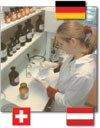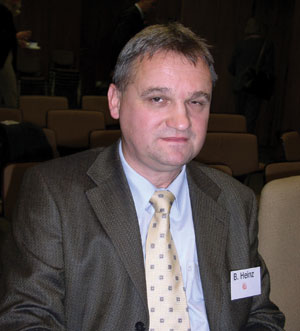

GD — Society for Dermopharmacy
 |
Issue 1 (2006) |
Dermopharmacy
News The symposium implemented in cooperation with Free University Berlin
and Bundesinstitut für Risikobewertung (Federal Institute for Risk
Assessment) (BfR) was under the scientific lead of Dr. Karl-Heinz Nietsch,
professor Dr. Monika Schäfer-Korting and professor Dr. Horst Spielmann.
Experts from the most varying fields of activity participated in the symposium
such as dermatology, plastical surgery, oral, maxillo-facial surgery,
pharmacy, cosmetology and jurisprudence who controversially discussed
the benefit/risk relation of the presented treatment methods. A noontime seminar by company Merz Pharmaceuticals GmbH was equally part
of the scientific program dealing with properties, effectiveness and questions
on safety of hyalurone-acid containing filler products. Following the
symposium, the company Collagen Aesthetics GmbH presented an additional
course in the scope of which the Hamburg dermatologist Dr. Andreas Britz
demonstrated the application of filler materials in practice to the circle
of interested people. The symposium was opened by addresses of the GD-president Dr. Joachim
Kresken, Viersen, the conference head professor Dr. Monika Schäfer-Korting,
Berlin and the dean of the department biology, chemistry, pharmacy of
the Free University Berlin, professor Dr. Hartmut Hilger. They advocated
the interdisciplinary subject matter of the symposium and emphasized the
fact that this was the first event ever dedicated to injectable filler
materials covering such a broad range of topics and experts participating.. Filler products employed in Germany are exclusively qualified as medicinal
products and thus subject to the responsibility of the Bundesinstitut
für Arzneimittel und Medizinprodukte (BfArM) (Federal Institute for
Drugs and Medicinal Products). Significant criterion for the question
whether a filler product can be classified as medicinal product is the
type of its main effect. Only if the latter comes about by a physical
and not by a pharmacological, immunological or metabolical effect the
product is classified as medicinal product and not as drug. This applies
independent from the fact whether the filler material considered is absorbable
or whether it is not. The patient information which is to be documented due to reasons of liability
has to be performed by the physician personally. A reference on the information
of the producer - also if it is provided with a practice stamp - is insufficient
as information measure. In case of inadequate information, the physician
is also liable if the intervention has been performed faultlessly and
workmanlike. The reason for this situation is that the jurisdiction strictly
distinguishes between treatment and information lapses. Beyond this procedure some practices and clinics have established their
own quality control measures in the context of filler products. As reported
by Dr. Natalia Brenner of Elisées Academy, Bonn, this comprises
the employment of imaging by means of which the result of wrinkle treatment
by injection can be objectively controlled. Thus for example the thickness
increase and collagen content of skin can be made visible by means of
skin ultra sonics. Dr. Claudia Borelli of Dermatologische Klinik der Ludwig- Maximilians-Universität
(Dermatological Clinic of Ludwig-Maximilians University), Munich, informed
about the use of Poly-L-lactic acid at facial lipodystrophy which is often
the case at HIV patients after an anti-viral therapy. Own experience of
the referee as well as results of the VEGA-study performed in France show
that the Poly-L-lactic acid is very effective in this treatment. Nevertheless,
the treatment result - even if sonographically an increase of the skin
thickness has been determined - is optically not always convincing. Advantages of the collagen treatment are besides the high safety standard
the easy injection technique, large scale of indications and long-term
application experience. Adversely are the relative little stability, the
necessary allergy test and the longer time/effect interval. Also a granuloma
formation cannot - as for other filler substances - be completely excluded. Native hyaluronic acid is water soluble and synthesized at the cell membrane
of fibroblasts. In the basal layer of the skin it is located intracellularly,
in upper layers extracellularly and reversibly crosslinked. The hyaluronic
acid used in filler products is at the time being mostly biotechnologically
extracted from bacteria cultures. Due to its ubiquitary source the substance
is not antigen so that the allergy test effected before a collagen treatment
is omitted. Intolerability appearing in only few cases after application
of hyaluronic acid fillers is caused by additives. For the latter the so-called CPM (cohesive poly-densified matrix) and
the DXL (double cross linked hyaluronic acid) methods are used. By the
CPM process monophasic gels with a period of effect of up to six months
can be produced which are recommended for the application at fine wrinkles.
The DXL process entails biphasic gels with smaller particles suitable
for the treatment of deeper wrinkles owing to their higher thermo and
in-vivo stability as well as their excellent spreadability. As the Munich dermatologist Dr. Sabine Zenker explained, also here the
particle size determines the indication profile: while the product with
the smaller particles (60-70 µm) is used for the correction of deeper
wrinkles and skin irregulatories and injected deeply into the dermis,
the one with the larger particles (80-90 µm) serves the "remodeling"
of facial contours and is accordingly deeply injected in the subcutaneous
adipose tissue. Both products are not indicated for superficial wrinkles. According to information by Dr. Dr. Christoph Lenzen, St. Josef-Hospital
Krefeld-Uerdingen, who is concerned with histological documentation and
treatment of complications after wrinkle treatment by facial injection,
granuloma frequently emerges after application of non-absorbable filler
materials. Compliant with a recommendation by the Deutsche Gesellschaft
für Ästhetische Chirurgie (German Society for Aesthetical Surgery)
it is recommended not to use these materials any longer. The facial areas which are mostly affected by disorders are in compliance
with Lenzen's survey the lip and nasolabial area. Lenzen complained that
in spite of the information duty patients treated by him due to complications
were oftentimes not informed about the material injected. Contra-indications and interactions have to be considered as well as
the fact that too large a quantity of absorbable materials is not completely
disintegrated. On the side of the patient the immunological status is
of major importance. Changes in the hormone status or in the T-cell imparted
defence increase the risk for granuloma. As Lenzen also other referees and participants in discussion pointed
out that the granuloma risk may not be neglected. It is to be considered
that granulomas being very delicate can never be completely removed by
surgery. Also the few existing medicamentous treatment options - intra-lesional
injections of hyaluronidasis, 5-fluorouracil or triamcinolone as well
as oral Allopurinol - are to be critically questioned in this indication.
GD-Symposium in Berlin on 17th November 2005
Benefit
and Risks of Injectable Filling Materials for Skin Augmentation
Report by Sylvia Schreiber, Berlin, Jan Kresken, Münster,
and Dr. Joachim Kresken, Viersen
In the course of the anti-aging trend and the wish of many people for
an attractive appearance, the invasive wrinkle treatment has gained vigorously
in importance. In Germany alone, according to estimations of different
organizations, approx. 50.000 facial injections per year, based on more
than hundred different preparations, are effected. At a symposium organized
by the Gesellschaft für Dermopharmazie in Berlin on 17 November 2005
under the title "Subcutaneous cosmetics and their alternatives: benefit
and risks of skin augmentation" available treatment methods and materials
were subject to a review and assessment under the most versatile aspects.
of filler preparations
The legal classification of filler products are of extraordinary
importance both under the aspects of marketability and consideration of
patient protection. Even the question of liability risks for the physician
depends to a major extent on the legal status of the product used. Lawyer
Dr. Susanne Götting of the partnership Graefe of Munich drew the attention
of the audience to this context.
to supply information
As the use of filler products is normally not medicinally indicated
it can only become legitimate by an effective patient consent. For this
aim, the applying physician informs the patient according to the wording
of the Federal Court of Justice "unsparingly", i. e. exhaustively
and without any reservation this includes information about possible risks
such as hazard of infection, scarring and paresthesia. Furthermore, he is
to refer to the fact that the success is not ensured and the application
of absorbable materials is of indeterminate duration.
A
filler product classified as medicinal product has to have the CE labeling
and undergo a conformity assessment procedure which though - differently
to drugs - has to be executed only in one member state within the EC. In
the course of this procedure the producer is obliged to adhere to the basic
requirements pf the product in a quality assurance procedure.

Lawyer
Dr. Susanne Götting of the partnership Graefe of Munich who is
also member of the Gesellschaft für Dermopharmazie - addressed
the legal general conditions of filler products. She emphasized that
before using these products comprehensive information of the patient
is required which has to be effected by the medicating physician personally.
treatment option
The poly-L-lactic acid belonging to absorbable filler materials
has been characterized more in detail by Dr. Birgit Wöhrle of Rosenparkklinik
Darmstadt. The substance entails an irritation and consequently a stimulation
of the collagen formation in skin, the cause however has not been clarified.
Repeated application reduces deep wrinkles in particular in the lower part
of the face for a duration of approx. one and a half years. When injecting
in the deeper dermis or subcutis lump or granuloma formation are to be avoided.
with collagens
Dr.
Andreas Britz, practice clinic at Rothenbaum, Hamburg designated as gold
standard of wrinkle augmentation, the application of bovine and porcine
collagens which have been available in the market for the longest time within
the group of filler products. Main application area of these products are
wrinkles in the lip and mouth area whereas the indication sectors differ
according to the product.

Dermatologist
Dr. Claudia Borelli of Dermatologische Klinik der Ludwig-Maximilians-Universität
(Dermatological Clinic of Ludwig-Maximilian-University), Munich, lectured
on the application of the filler substance Poly-L-lactic acid at lipodystrophy
of the face of a HIV-infected person. In a further lecture she addressed
the unwanted effects of filler products from a dermatological view.
on the rise
According to the view of the plastical surgeon Dr. Johannes Reinmüller
of the Clinic at the Sonnenberg, Wiesbaden, and dermatologist Lucie Rauch,
Dermatological Clinic, Heinrich-Heine University, Düsseldorf, at the
present time no longer collagens but filler materials on basis of hyalurone
acid are the gold standard in wrinkle therapy. They are employed for the
augmentation of deep wrinkles, such as nasolabial-, corner of the mouth
and glabella wrinkles, lip augmentation, at perioral minor crinkles, crow's
feet, at lipodystrophy-syndromes in the cheek sector as well as for chin
and cheekbone build up.
Due to the fact that hyaluronic acid is very swiftly disintegrated
in skin by hyaluronidases, oxidative processes and phagozytoses it has to
be stabilized for uses in filler products. As the oral, maxillo-facial surgeon
Dr. Dr. Christiane Gutsche, Düsseldorf, explained, this may be the
case by ether cross-linkage and also by increase of the particle size.
filler products
Besides absorbable also different non-absorbable filler materials
are available for the treatment of deep wrinkles. Among those is silicone,
a combination product on basis of polymethyl methacrylat and collagen as
well as two products which both consist to 60 percent of hyaluronic acid
and 40 percent of acryl hydrogel and distinguish in the size of the acryl
hydrogel particles.
Besides the characterization of the avail, the symposium dealt
also very detailed with the hazards of filler products. Complications may
be preliminary local effects such as swelling, reddening, infections and
pigmentation disorders, moreover also permanent side effects such as abscess
formation, foreign body granuloma and local necroses.
The
reasons of possible disturbances are not only related to the product used
but also to the person effecting the treatment and the patient. The person
effecting the treatment should have an appropriate training and avoid facial
areas with thin skin and low subcutaneous adipose tissue when effecting
the treatment of wrinkles by injection

Pursuant
to the interdisciplinary character of the GD, the subject matter of
the symposium in Berlin was of significance across disciplines. The
symposium offered the possibility for an exchange of thoughts and
excitation for the pursuance of different question topics to experts
participating from the most differing departments and institutions.
for side effects
Dr. Bruno Heinz of BfArM, Bonn, drew the attention of the audience
to the obligation of notification on side effects after employment of filler
materials. The obligation to inform as stipulated in § 29 of Medizinproduktegesetz
(MPG) (Medicinal Product Law) underlie both producers and also users of
medicinal products. In the last six years 143 notifications on side effects
concerning filler products have been filed with the BfArM. Subject of the
notification were granuloma in over 60 % of the cases. Due to the notifications
submitted so far only one product has been recalled.
 The physician Dr. Bruno Heinz participated as representative of the Bundesinstitut für Arzneimittel und Medizinprodukte (BfArM) (Federal Institute for Drugs and Medicinal Products) in the symposium in Berlin. In his lecture he presented the observation and notification system for medicinal products in Germany by the example of filler products. |
According to the evaluation of several symposium participants the disproportionately low number of notifications implies a high number of unreported cases. Obviously many physicians are not aware of the fact that complications after application of filler products fulfill in many cases the elements of an offence of a severe aggravation of the health state in the sense of MPG and are therefore subject to notification.
An additional reason for the high estimated number of unknown cases is seen in the fact that injectable filler products are also applied by non-physicians. This problem may possibly be solved - according to the proposal of a symposium participant - by classifying filler products as prescription drugs. After all there are other medicinal products with rather low risk potential which are also available on prescription only (for example dimethyl sulfoxide-containing ear drops).
Significance ofbotulinum toxin A
Besides filler products also the role of botulinum toxin A has been addressed in the scope of the symposium. In Germany it is available as prescription drug. As Lucie Rauch from the Dermatological Clinic at Heinrich-Heine-University in Düsseldorf explained, the anti-wrinkle effect of this substance consists of a selective and irreversible blocking of the release of acetyl choline from the neuro-muscular end plate which leads to a limp paralyzation of the skeleton muscular system at the place of the injection.
The effect abates about three to six months after the injection as a re-sprouting of axon terminals at the nerve endings comes then about. In order to prevent major paralyzes the anatomy of the facial muscular system has to be considered. Recommended is merely the application in the upper part of the face. Injections in the lower part of the face have in many times caused problems while speaking and eating. An excessive treatment entails mimic rigor.
Alternatives to filler productsDr. Andreas Britz, Hamburg, sees an alternative to the application of filler products in the chemical peeling, which is to be especially recommended at minor wrinkles and light-induced skin ageing. The optimal success can be achieved in the face, eye, and throat region as here the follicle density and skin regeneration level are very high. As concerns the ingredients of peeling products, besides other organic acids surprisingly phenol and resorcin are still used although these substances are considered to be critical and therefore their use in medicaments is no longer allowed.
An additional alternative to wrinkle augmentation is the method of autologous fat transplantation which was presented by Dr. Birgit Wörle, Darmstadt. Here the patient is subcutaneously injected his own fat tissue, which has been extracted in a tumenescence process or by liposuction and cleaned from connective tissue. Major application areas are wrinkles in the entire facial area and deep circumorbital rings. A repeated application is required. Side effects are among others pain, erythema and oedema while the risk of a fat embolism is only very little when using blunt canulas.
 The dermatologist Lucie Rauch is head of the department for aesthetical dermatology at Dermatological Clinic Heinrich-Heine-Heine University Düsseldorf. She holds lectures on the practical application of hyaluronic acid fillers and the role of botulinum toxin A in wrinkle treatment. |
Professor Dr. Ulrike Heinrich of Institut für experimentelle Dermatologie (Institute for Experimental Dermatologie) at University Witten/Herdecke tried to answer the question whether respectively to which extent the effects of injectable filler materials can equally be obtained by employing cosmetic agents. She demonstrated by means of studies based on objective methods in which roughness, scaling, smoothness and wrinkle depth of the skin was measured, that certain care creams are indeed able to smoothen dryness wrinkles on a limited scale, they are however no real alternatives to filler products.
Summary and outlookIn summarizing words, the acting president of the GD, professor Dr. Hans Christian Korting of Dermatologische Klinik (Dermatological Clinic) at Ludwig-Maximilians-University Munich, stressed the interdisciplinarity and high degree of topicality of the subject matter dealt with. A trend in direction of skin augmentation can be observed the possibilities and benefit/risk balance of which has been clearly presented in the course of the symposium.
Lectures and discussion contributions of the symposium have been subject
to continued reflection on certain questions. Korting expresses his special
thanks to all moderators and lecturers, the Free University Berlin as
host as well as the organizers and sponsors.
top